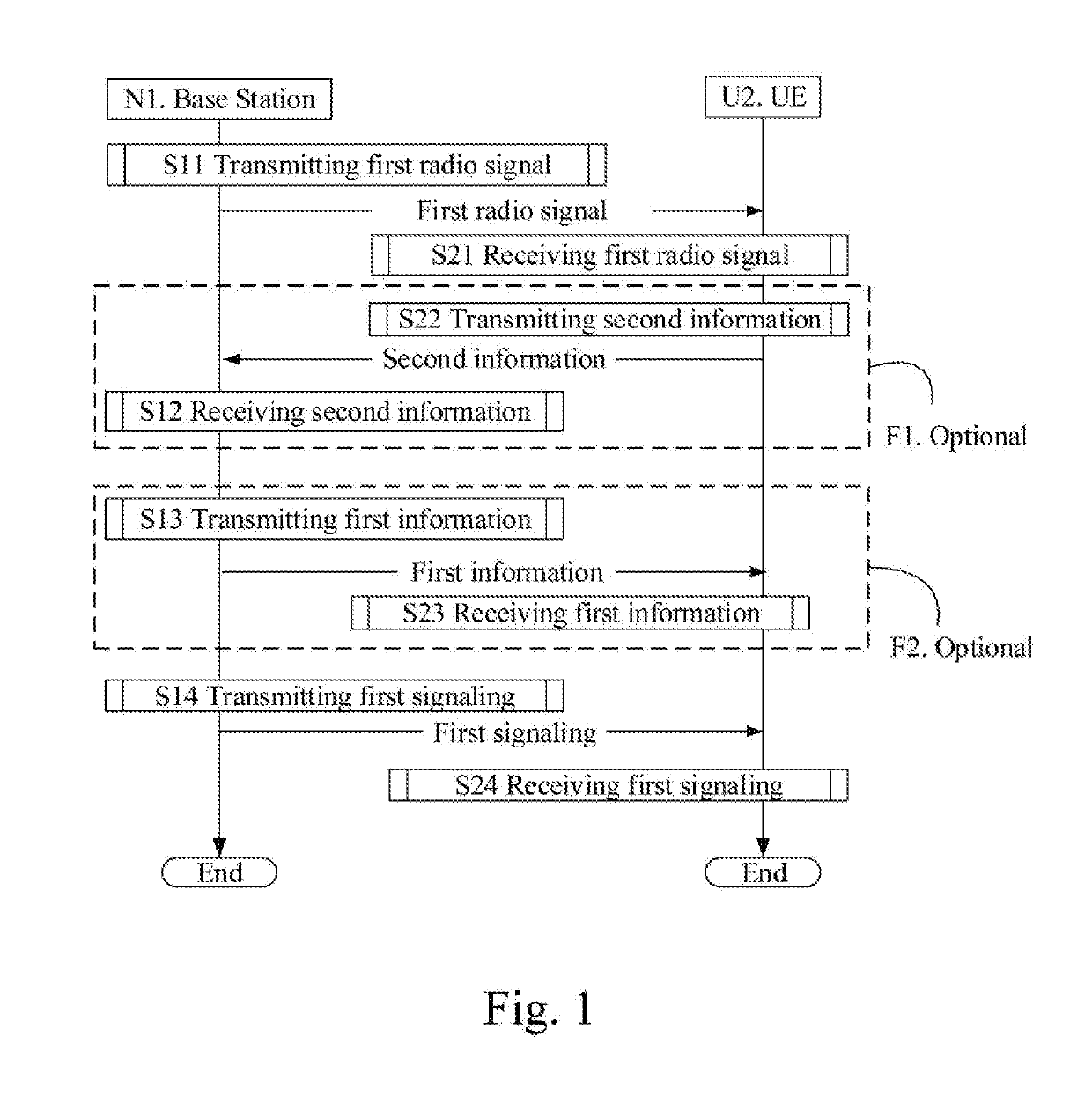Method and Device for Multi-Antenna Transmission in UE and Base Station
- Summary
- Abstract
- Description
- Claims
- Application Information
AI Technical Summary
Benefits of technology
Problems solved by technology
Method used
Image
Examples
embodiment 1
[0275]Embodiment 1 illustrates a flow chart of wireless transmission according to one embodiment of the present disclosure, as shown in FIG. 1. In FIG. 1, the base station N1 is a maintenance base station of the serving cell of the UE U2. In the figure, the step in the box identified as F1 and F2 are optional, respectively.
[0276]The base station N1 transmits the first radio signal in step S11; receives the second information in step S12; transmits the first information in step S13; and transmits the first signaling in step S14.
[0277]The UE U2 receives the first radio signal in step S21; transmits the second information in step S22; receives the first information in step S23; and receives the first signaling in step S24.
[0278]In Embodiment 1, the first radio signal is transmitted by K antenna port groups, the antenna port group(s) includes a positive integer number of the antenna port(s); a first antenna port group is one of the K antenna port groups; the first signaling is used to d...
embodiment 2
[0285]Embodiment 2 illustrates a flowchart of wireless transmission according to another one embodiment of the present disclosure, as shown in FIG. 2. In FIG. 2, the base station N3 is a maintenance base station of the serving cell of the user equipment U4. In Embodiment II, the N3 can reuse steps S11-S13 in FIG. 1 before step 31; the U4 can reuse steps S21-S23 in FIG. 1 before step S41. In FIG. 2, the step in the box identified as F3 and F4 are optional, respectively.
[0286]The base station N3 transmits a first signaling in step S31; transmits a second signaling in step S32; receives second radio signal in the first time resource sub-pool in step S33.
[0287]The UE U4 monitors a first signaling in the third time resource pool in step S41; receives the first signaling in step S42; monitors a second signaling in the second time resource pool in step S43; receives the second signaling in step S44; transmits the second radio signal in the first time resource sub-pool in step S45.
[0288]In ...
embodiment 3
[0294]Embodiment 3 illustrates a flowchart of wireless transmission in accordance with yet another embodiment of the present disclosure, as shown in FIG. 3. In FIG. 3, a base station N5 is a maintenance base station for a serving cell of the UE U6. In Embodiment 3, the N5 can reuse steps S11-S13 in FIG. 1 and steps S31-S32 in FIG. 2 prior to step 51; the U4 can reuse steps S21-S23 in FIG. 1 and steps S41-S44 before in FIG. 2 prior to step S61.
[0295]The base station N5 transmits the second radio signal in the first time resource sub-pool in step S51.
[0296]The UE U6 receives the second radio signal in the first time resource sup-pool in step S61.
PUM
 Login to view more
Login to view more Abstract
Description
Claims
Application Information
 Login to view more
Login to view more - R&D Engineer
- R&D Manager
- IP Professional
- Industry Leading Data Capabilities
- Powerful AI technology
- Patent DNA Extraction
Browse by: Latest US Patents, China's latest patents, Technical Efficacy Thesaurus, Application Domain, Technology Topic.
© 2024 PatSnap. All rights reserved.Legal|Privacy policy|Modern Slavery Act Transparency Statement|Sitemap



